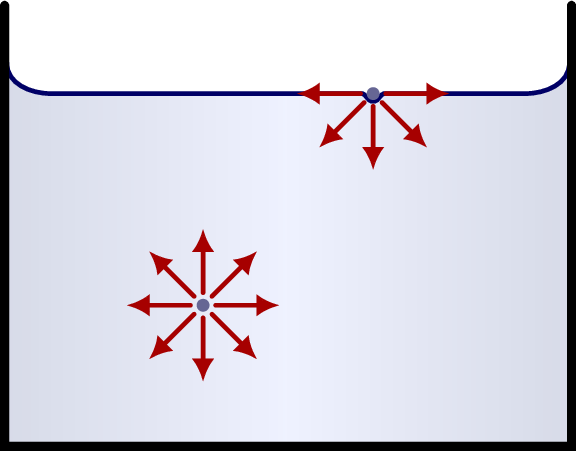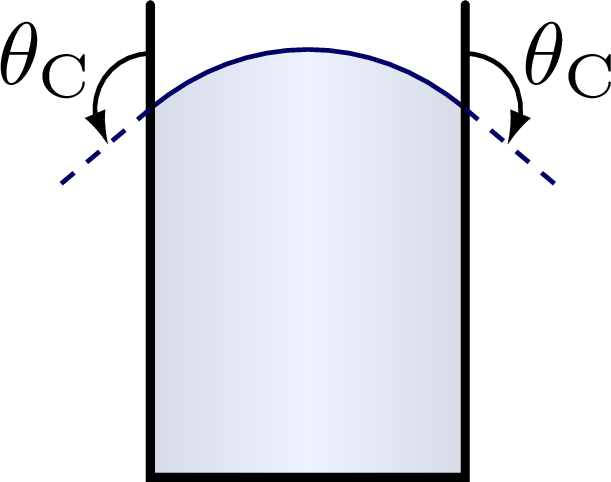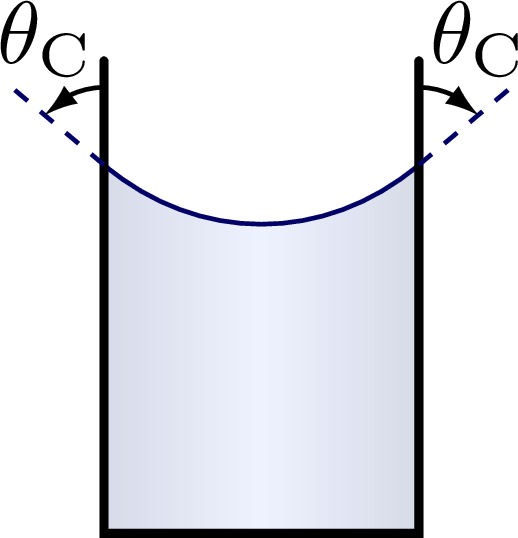Surface tension & capillary action.
For more related figures, please have a look at the Fluid Dynamics category.
Edit and compile if you like:
% Author: Izaak Neutelings (November 2020)\documentclass[border=3pt,tikz]{standalone}\usepackage{physics}\usepackage{tikz}\usepackage[outline]{contour} % glow around text\usetikzlibrary{patterns,decorations.pathmorphing}\usetikzlibrary{decorations.markings}\usetikzlibrary{angles,quotes} % for pic (angle labels)\usetikzlibrary{arrows.meta}\usetikzlibrary{bending} % for arrow head angle\usetikzlibrary{calc}\tikzset{>=latex}\contourlength{1.1pt}\colorlet{mydarkblue}{blue!40!black}\colorlet{myblue}{blue!70!black}\colorlet{myred}{red!65!black}\colorlet{vcol}{green!45!black}\colorlet{watercol}{blue!80!cyan!8!white}\colorlet{darkwatercol}{blue!80!cyan!80!black!30!white}\colorlet{metalcol}{blue!25!black!30!white}\tikzstyle{piston}=[blue!50!black,top color=blue!30,bottom color=blue!50,middle color=blue!20,shading angle=0]\tikzstyle{water}=[draw=mydarkblue,rounded corners=0.1,top color=watercol!80,bottom color=watercol!90!black,middle color=watercol!40,shading angle=20]\tikzstyle{horizontal water}=[water,top color=watercol!90!black!90,bottom color=watercol!90!black!90,middle color=watercol!80,shading angle=0]\tikzstyle{metal}=[draw=metalcol!10!black,rounded corners=0.1,top color=metalcol,bottom color=metalcol!80!black,shading angle=10]\tikzstyle{vvec}=[->,very thick,vcol,line cap=round]\tikzstyle{force}=[->,myred,very thick,line cap=round]\tikzstyle{width}=[{Latex[length=4,width=3]}-{Latex[length=4,width=3]}]\tikzstyle{mydashed}=[dash pattern=on 1.5pt off 1.5pt]\begin{document}% SURFACE TENSION in container\begin{tikzpicture}\def\W{1.8} % tank width\def\H{1.4} % height tank\def\h{0.80*\H} % height water\def\F{0.2} % vector magnitude\def\r{0.02} % radius dot\def\x{0.15*\W} % x position surface dot
Click to download: fluid_dynamics_surface_tension.tex • fluid_dynamics_surface_tension.pdf
Open in Overleaf: fluid_dynamics_surface_tension.tex






